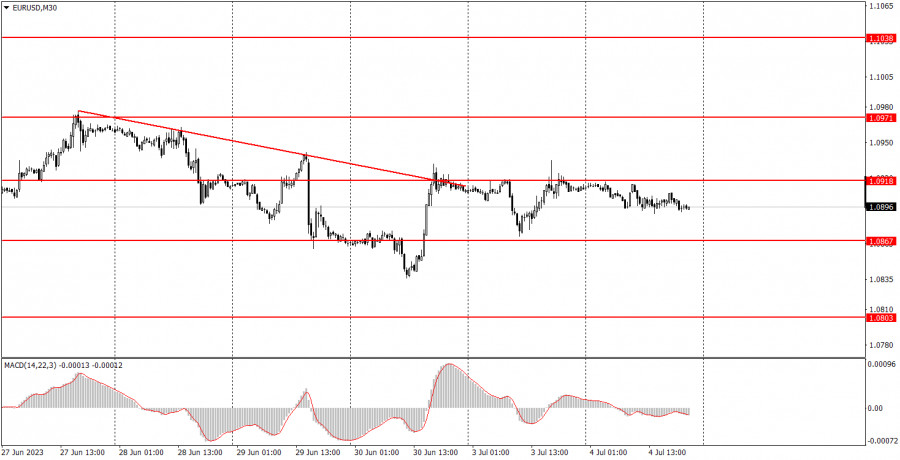

A couple of economic events are scheduled for Wednesday. Essentially, we can only highlight the services PMIs of Germany, the United Kingdom, and the EU. In all three cases, traders will receive the final, second values of the indicators, which are unlikely to differ significantly from the first estimates published two weeks ago. Therefore, we don't expect a strong reaction. However, the general trend of the PMIs has been a slowdown, so there is a possibility that the actual values could be worse than expectations, which may exert slight pressure on the euro and the pound. However, the euro is standing still at the moment, and the pound can grow under any conditions.
Overview of fundamental eventsThere will be two fundamental events on Wednesday. Both are late in the evening. The minutes of the last Federal Reserve meeting will be published in the US, at which officials announced a pause in interest-rate hikes. Usually, the minutes does not stir any market reaction, as it rarely contains important information that the market doesn't know. However, there are exceptions to every rule. In any case, beginners can leave the market before this event.
Also, one of the members of the FOMC, John Williams, will make a speech. In recent weeks, we have heard several speeches from his colleagues, so we already know what to expect from the Fed. And we believe that this information does not provide much support to the dollar. Therefore, we don't expect much from Williams' speech either.

On Wednesday, the macroeconomic background will be very weak, so we believe that volatility will remain lower. The evening events could theoretically provoke a surge of emotions in the market. Most likely, we should brace ourselves for another boring day ahead of a crazy Thursday and Friday.
Main rules of the trading system:The strength of the signal is calculated by the time it took to form the signal (bounce/drop or overcoming the level). The less time it took, the stronger the signal.If two or more trades were opened near a certain level due to false signals, all subsequent signals from this level should be ignored.In a flat market, any currency pair can generate a lot of false signals or not generate them at all. But in any case, as soon as the first signs of a flat market are detected, it is better to stop trading.Trades are opened in the time interval between the beginning of the European session and the middle of the American one when all trades must be closed manually.On the 30-minute timeframe, you can trade based on MACD signals only on the condition of good volatility and provided that a trend is confirmed by the trend line or a trend channel.If two levels are located too close to each other (from 5 to 15 points), they should be considered as an area of support or resistance.Comments on chartsSupport and resistance levels are levels that serve as targets when opening long or short positions. Take Profit orders can be placed around them.
Red lines are channels or trend lines that display the current trend and show which direction is preferable for trading now.
The MACD (14,22,3) indicator, both histogram and signal line, is an auxiliary indicator that can also be used as a source of signals.
Important speeches and reports (always found in the news calendar) can significantly influence the movement of a currency pair. Therefore, during their release, it is recommended to trade with utmost caution or to exit the market to avoid a sharp price reversal against the previous movement.
Beginners trading in the forex market should remember that not every trade can be profitable. Developing a clear strategy and money management is the key to success in trading over a long period of time.